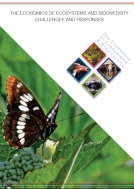Because nature is often invisible in the economic choices we make, we have steadily been drawing down our natural capital—without understanding either what it really costs to replace services provided for free by nature, or that man-made alternative solutions are sometimes far too expensive for these services to be replaced or substituted.
The TEEB initiative seeks to draw attention to the invisibility of nature in the economic choices we make across the domains of international, national, and local policy-making, public administration, and business. TEEB sees this invisibility as a key driver of the ongoing depletion of ecosystems and biodiversity.
TEEB advocates a three-step approach to analyzing and structuring valuation of biodiversity and ecosystem services, guided by three principles:
- Recognizing value in ecosystems, landscapes, species and other aspects of biodiversity is a feature of all human societies and communities and is sometimes sufficient to ensure conservation and sustainable use. For example, the existence of sacred groves in some cultures has helped to protect natural areas and the biodiversity they contain.
- Demonstrating value in economic terms is often useful for decision-makers to consider the full costs and benefits of nature rather than just those that enter the markets in the form of private goods. An example would include calculating the values of conserving the ecosystem services provided by wetlands in controlling floods, as compared to building flood defenses.
- Capturing value involves the introduction of mechanisms that incorporate the values of biodiversity and ecosystems into decision-making through incentives and price signals. This can include payments for ecosystem services, reforming environmentally harmful subsidies or introducing tax breaks for conservation.
Is TEEB ‘putting a price on Nature’?
Regarding TEEB and valuation in general, there exists a concern that we are ‘financializing’ nature and its services, which will ultimately lead to its commodification and marketization. More specifically, this criticism suggests that nature, once its values are identified and expressed in monetary terms, will become a market commodity and, like any other, subject to free trade. Moreover, it is argued that, in becoming privatized, previously public ecosystem goods and services will become accessible to the very same private interests responsible for our planet’s degradation.
Though these are valid concerns, it could be argued that essential ecosystem services are already being ‘traded’ in precisely this manner, sometimes for an implicit price of zero. Land concessions granted for mining or logging usually do not account for the ecosystem services lost through subsequent land-use change. Ocean commons continue to be open access and free. If nothing else, valuation in combination with liability regulations makes destructive extraction less attractive by adding (usually quite significant) financial costs.
Placing a value on nature’s ecosystem services should not be misconstrued as ‘putting a price on nature’. Economic policy utilizes several instruments – some market-based and some not – to reflect the value of nature’s services. TEEB does not suggest placing blind faith in the ability of markets to optimize social welfare by privatizing the ecological commons and letting markets discover prices for them. What TEEB offers is both a model for communicating to decision-makers in their own language, dominated by economics, as well as a toolkit for evaluating and integrating good stewardship into their decisions.
 Read more about how TEEB addresses these and other criticisms in “TEEB: Challenges and Responses” (2014).
Read more about how TEEB addresses these and other criticisms in “TEEB: Challenges and Responses” (2014).
This presentation below given by Dr Andrea Bassi to the Africa Natural Accounting Community of Practice is a useful entry point to explaining scenario analysis and modelling fit into the TEEB Approach. It was delivered in the context of the TEEB work on Natural Capital Accounting but refers also to the TEEB Tanzania EU ENRTP-funded Country Study which has a agri-food dimension. The presentation shows the need to integrate different types of models in order to answer policy questions that have economic, social and ecological dimensions.
